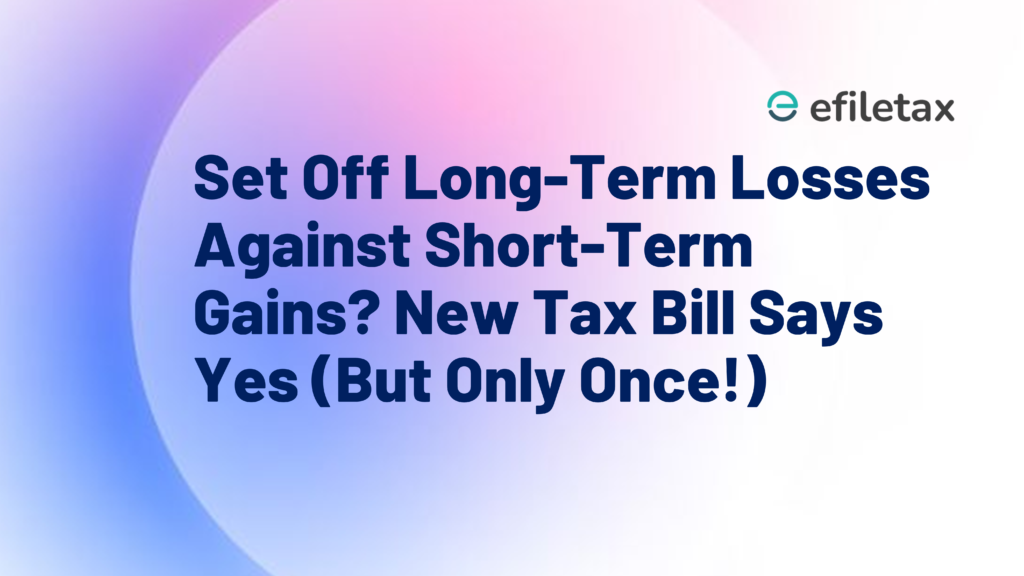
Introduction
One-time LTCG set off is now permitted under the Draft Income Tax Bill, 2025. Starting tax year 2026–27, taxpayers will be allowed to set off long-term capital losses (LTCL) against short-term capital gains (STCG) — a major shift from the old law under the Income-tax Act, 1961.
Let’s break down what this means, why it matters, and who benefits.
What Changes in the New Income Tax Bill?
Under the Income-tax Act, 1961, you could:
- Set off short-term capital loss (STCL) against any capital gain (long- or short-term)
- Set off long-term capital loss (LTCL) only against long-term capital gains (LTCG)
Under the Draft Income Tax Bill, 2025:
- For tax year 2026–27 only, you can set off LTCL against STCG
- This is a one-time transitional benefit
- Applies to LTCL carried forward from earlier years under the old Act
Legal Basis for the Change
- Clause 323(4) of the Draft Bill provides this one-time relief
- The aim: avoid hardship during the transition from the old Act (1961) to the new Act (2025)
- Relevant for those with unutilized long-term capital losses till FY 2025–26
Reference: Draft Direct Taxes Code, 2025 (Clause 323(4))
Who Benefits from One-Time LTCG Set Off?
This provision is beneficial if:
- You had LTCL from equity, property, or gold in FY 2023–24, 2024–25, or 2025–26
- You’re expecting STCG in FY 2026–27
- You haven’t been able to fully utilise carried forward LTCL under the old rule
Example:
If you had ₹2 lakh LTCL from listed shares in FY 2024–25 and earn ₹1.5 lakh STCG in FY 2026–27, you can now set it off, reducing taxable capital gain to zero.
Conditions to Avail Set Off
| Condition | Details |
|---|---|
| Applicable year | FY 2026–27 (AY 2027–28) only |
| Loss type | LTCL under old Act |
| Gain type | STCG under new Act |
| Set off limit | Up to available carried-forward LTCL |
| Carry forward rules | As per old Act till FY 2025–26 |
This does not extend the 8-year time limit under the 1961 Act for loss carry forward.
Expert View: Why This Matters
“This one-time window allows better tax planning during the transition. Taxpayers with historic long-term losses finally have a way to monetise them, even if future gains are short-term.”
— CA Rohit P., Tax Consultant at Efiletax
Practical Steps to Avail the Benefit
- Check your capital loss schedule for carried forward LTCL in ITR till FY 2025–26
- Maintain records of computation and original returns filed
- Offset eligible STCG during FY 2026–27
- Report accurately in ITR AY 2027–28 under new schedule
Summary
From FY 2026–27, taxpayers can avail a one-time LTCG set off benefit under the new Income Tax Bill. This allows carried forward long-term capital losses from the old Act to be set off against short-term capital gains — a transitional relief not permitted earlier.
FAQs: One-Time LTCG Set Off
Q1. Is this benefit available every year?
No. It is available only for FY 2026–27 (AY 2027–28) as a one-time relief.
Q2. Can I carry forward unused LTCL beyond FY 2026–27 under the new Act?
No. Post this transition, losses will be governed by the new Act. Old losses not adjusted will lapse after expiry.
Q3. Do I need to submit any separate form?
Not notified yet. But recordkeeping of past ITRs and computation is crucial.
Final Thoughts
The one-time LTCG set off provision is a taxpayer-friendly transitional clause that helps reduce capital gains tax in FY 2026–27. For those with pending LTCLs under the old law, this is a valuable opportunity to offset and save.